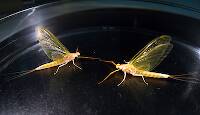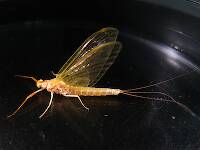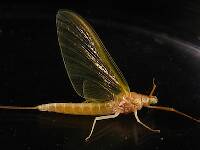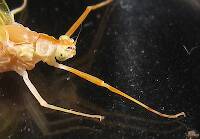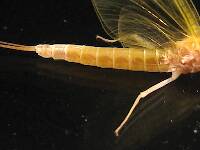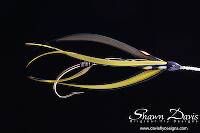
Blue-winged Olives
Baetis
Tiny Baetis mayflies are perhaps the most commonly encountered and imitated by anglers on all American trout streams due to their great abundance, widespread distribution, and trout-friendly emergence habits.
Featured on the forum


Troutnut is a project started in 2003 by salmonid ecologist Jason "Troutnut" Neuswanger to help anglers and
fly tyers unabashedly embrace the entomological side of the sport. Learn more about Troutnut or
support the project for an enhanced experience here.
Jjlyon01 on Nov 19, 2008November 19th, 2008, 6:17 am EST
I am doing a project in my latin class on Mayflies of North America. I must derive the latin names of each species, determine the declension, and case. I am having a hard time finding these names in any latin dictionary. Is there anyone who may have a good resource for me to find this information in?
"I now walk into the wild"
Creno on Nov 19, 2008November 19th, 2008, 7:00 am EST
This may be more than you want:
COMPOSITION OF SCIENTIFIC WORDS
A manual of methods and a lexicon of materials for the practice of logotechnics
ROLAND WILBUR BROWN Geologist, U. S. Geological Survey
Information: Book Title: Composition of Scientific Words: A Manual of Methods and a Lexicon of Materials for the Practice of Logotechnics. Contributors: Roland Wilbur Brown - author. Publisher: Smithsonian Institution Press. Place of Publication: Washington, DC. Publication Year: 1956. Page Number: *.
COMPOSITION OF SCIENTIFIC WORDS
A manual of methods and a lexicon of materials for the practice of logotechnics
ROLAND WILBUR BROWN Geologist, U. S. Geological Survey
Information: Book Title: Composition of Scientific Words: A Manual of Methods and a Lexicon of Materials for the Practice of Logotechnics. Contributors: Roland Wilbur Brown - author. Publisher: Smithsonian Institution Press. Place of Publication: Washington, DC. Publication Year: 1956. Page Number: *.
Creno on Nov 19, 2008November 19th, 2008, 7:15 am EST
another one I like:
Jaeger, Edmund C., 1944. A Source Book of Biological Names and Terms, C.T. Thomas publisher.
Jaeger, Edmund C., 1944. A Source Book of Biological Names and Terms, C.T. Thomas publisher.
Troutnut on Nov 19, 2008November 19th, 2008, 7:23 am EST
Remember that there's a big difference between Latin and Latinized. Lots of scientific names are just English words, or some entomologist's girlfriend's name or something, with Latin suffixes tacked on the end. And some of them (like Isonychia bicolor) don't even seem to be Latinized.
You'll have to pick and choose your species to find good Latin words from your class. There are plenty to choose from, but don't get hung up on any particular name that doesn't seem to be Latin... it probably isn't.
I bet Louis can help. I know he's fluent in at least one dead language. ;)
You'll have to pick and choose your species to find good Latin words from your class. There are plenty to choose from, but don't get hung up on any particular name that doesn't seem to be Latin... it probably isn't.
I bet Louis can help. I know he's fluent in at least one dead language. ;)
Jason Neuswanger, Ph.D.
Troutnut and salmonid ecologist
Troutnut and salmonid ecologist
Jjlyon01 on Nov 19, 2008November 19th, 2008, 9:34 am EST
Thank you for the help. I figured that some of the species names weren't in latin.
"I now walk into the wild"
Martinlf on Nov 19, 2008November 19th, 2008, 9:35 am EST
The previous recommendations, which I am not familiar with, may prove to be better references, but early chapters (1-7) of Wheelock's Latin give a clear sense of different declensions that may be useful. Chapter 7 in fact has some tips for common endings in the third declension that may help, though offhand most of the names that come to mind seem simple first declension nominative, such as Drunella cornuta. Roger, what do you think?
"He spread them a yard and a half. 'And every one that got away is this big.'"
--Fred Chappell
--Fred Chappell
Taxon on Nov 19, 2008November 19th, 2008, 11:17 am EST
Louis-
In response to your rhetorical question, I shall rely on Mark Twain, who advises, "It is better to keep your mouth closed and let people think you are a fool than to open it and remove all doubt."
Roger, what do you think?
In response to your rhetorical question, I shall rely on Mark Twain, who advises, "It is better to keep your mouth closed and let people think you are a fool than to open it and remove all doubt."
Martinlf on Nov 19, 2008November 19th, 2008, 12:37 pm EST
I knew we'd get a good answer out of our one and only Taxon.
"He spread them a yard and a half. 'And every one that got away is this big.'"
--Fred Chappell
--Fred Chappell
Quick Reply
Related Discussions
Topic
Replies
Last Reply
12
Apr 11, 2007
by Taxon
by Taxon
14
Jun 15, 2012
by Entoman
by Entoman





